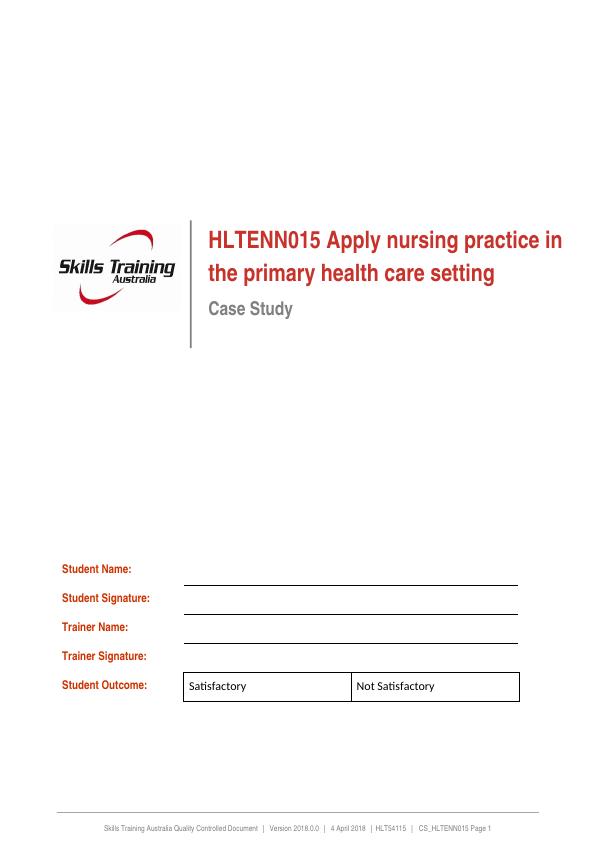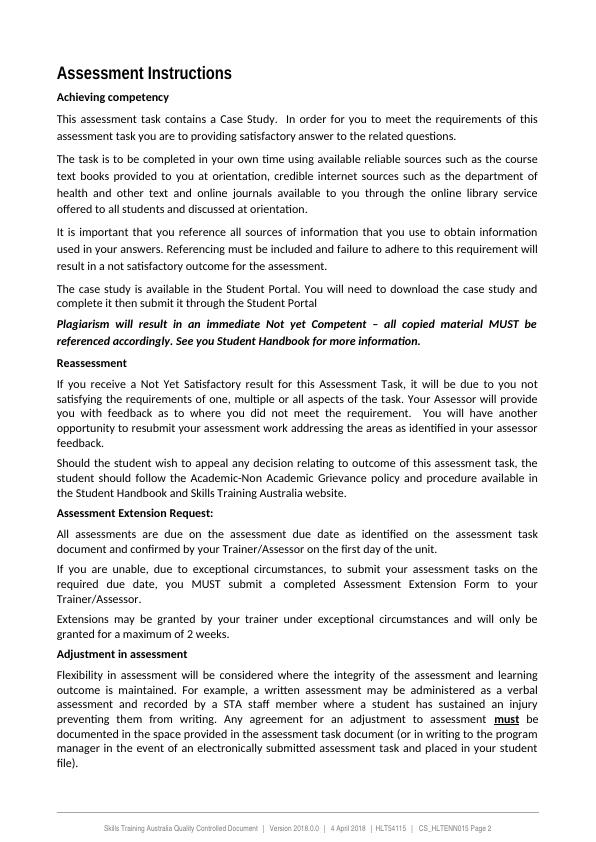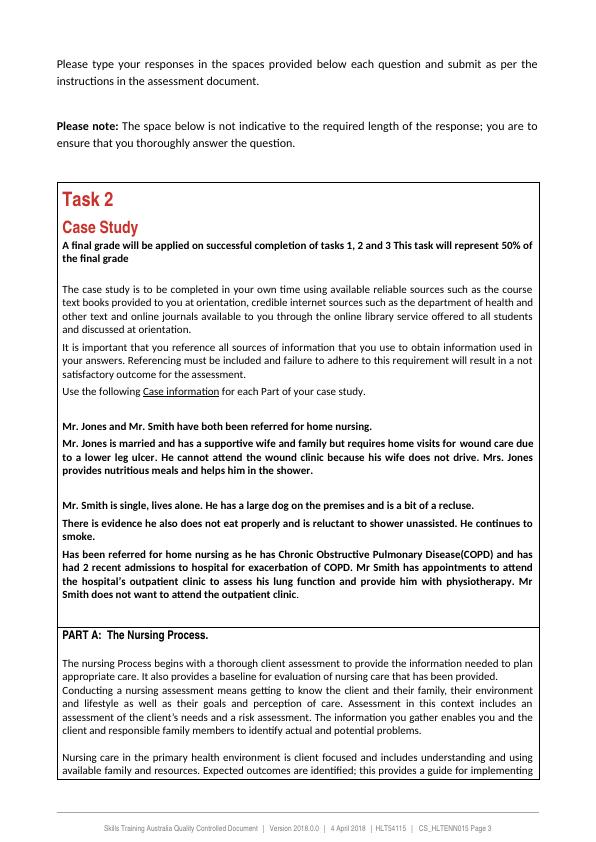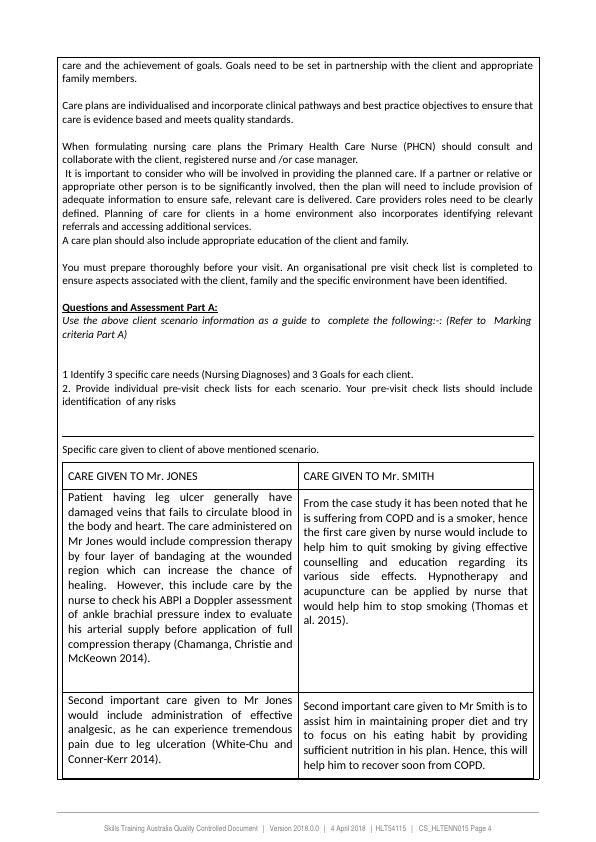Nursing Process and Intervention for Mr. Jones and Mr. Smith
Added on 2023-04-21
14 Pages6012 Words409 Views
Student Name:
Student Signature:
Trainer Name:
Trainer Signature:
Student Outcome: Satisfactory Not Satisfactory
Skills Training Australia Quality Controlled Document │ Version 2018.0.0 │ 4 April 2018 │HLT54115 │ CS_HLTENN015 Page 1
HLTENN015 Apply nursing practice in
the primary health care setting
Case Study
Student Signature:
Trainer Name:
Trainer Signature:
Student Outcome: Satisfactory Not Satisfactory
Skills Training Australia Quality Controlled Document │ Version 2018.0.0 │ 4 April 2018 │HLT54115 │ CS_HLTENN015 Page 1
HLTENN015 Apply nursing practice in
the primary health care setting
Case Study

Assessment Instructions
Achieving competency
This assessment task contains a Case Study. In order for you to meet the requirements of this
assessment task you are to providing satisfactory answer to the related questions.
The task is to be completed in your own time using available reliable sources such as the course
text books provided to you at orientation, credible internet sources such as the department of
health and other text and online journals available to you through the online library service
offered to all students and discussed at orientation.
It is important that you reference all sources of information that you use to obtain information
used in your answers. Referencing must be included and failure to adhere to this requirement will
result in a not satisfactory outcome for the assessment.
The case study is available in the Student Portal. You will need to download the case study and
complete it then submit it through the Student Portal
Plagiarism will result in an immediate Not yet Competent – all copied material MUST be
referenced accordingly. See you Student Handbook for more information.
Reassessment
If you receive a Not Yet Satisfactory result for this Assessment Task, it will be due to you not
satisfying the requirements of one, multiple or all aspects of the task. Your Assessor will provide
you with feedback as to where you did not meet the requirement. You will have another
opportunity to resubmit your assessment work addressing the areas as identified in your assessor
feedback.
Should the student wish to appeal any decision relating to outcome of this assessment task, the
student should follow the Academic-Non Academic Grievance policy and procedure available in
the Student Handbook and Skills Training Australia website.
Assessment Extension Request:
All assessments are due on the assessment due date as identified on the assessment task
document and confirmed by your Trainer/Assessor on the first day of the unit.
If you are unable, due to exceptional circumstances, to submit your assessment tasks on the
required due date, you MUST submit a completed Assessment Extension Form to your
Trainer/Assessor.
Extensions may be granted by your trainer under exceptional circumstances and will only be
granted for a maximum of 2 weeks.
Adjustment in assessment
Flexibility in assessment will be considered where the integrity of the assessment and learning
outcome is maintained. For example, a written assessment may be administered as a verbal
assessment and recorded by a STA staff member where a student has sustained an injury
preventing them from writing. Any agreement for an adjustment to assessment must be
documented in the space provided in the assessment task document (or in writing to the program
manager in the event of an electronically submitted assessment task and placed in your student
file).
Skills Training Australia Quality Controlled Document │ Version 2018.0.0 │ 4 April 2018 │HLT54115 │ CS_HLTENN015 Page 2
Achieving competency
This assessment task contains a Case Study. In order for you to meet the requirements of this
assessment task you are to providing satisfactory answer to the related questions.
The task is to be completed in your own time using available reliable sources such as the course
text books provided to you at orientation, credible internet sources such as the department of
health and other text and online journals available to you through the online library service
offered to all students and discussed at orientation.
It is important that you reference all sources of information that you use to obtain information
used in your answers. Referencing must be included and failure to adhere to this requirement will
result in a not satisfactory outcome for the assessment.
The case study is available in the Student Portal. You will need to download the case study and
complete it then submit it through the Student Portal
Plagiarism will result in an immediate Not yet Competent – all copied material MUST be
referenced accordingly. See you Student Handbook for more information.
Reassessment
If you receive a Not Yet Satisfactory result for this Assessment Task, it will be due to you not
satisfying the requirements of one, multiple or all aspects of the task. Your Assessor will provide
you with feedback as to where you did not meet the requirement. You will have another
opportunity to resubmit your assessment work addressing the areas as identified in your assessor
feedback.
Should the student wish to appeal any decision relating to outcome of this assessment task, the
student should follow the Academic-Non Academic Grievance policy and procedure available in
the Student Handbook and Skills Training Australia website.
Assessment Extension Request:
All assessments are due on the assessment due date as identified on the assessment task
document and confirmed by your Trainer/Assessor on the first day of the unit.
If you are unable, due to exceptional circumstances, to submit your assessment tasks on the
required due date, you MUST submit a completed Assessment Extension Form to your
Trainer/Assessor.
Extensions may be granted by your trainer under exceptional circumstances and will only be
granted for a maximum of 2 weeks.
Adjustment in assessment
Flexibility in assessment will be considered where the integrity of the assessment and learning
outcome is maintained. For example, a written assessment may be administered as a verbal
assessment and recorded by a STA staff member where a student has sustained an injury
preventing them from writing. Any agreement for an adjustment to assessment must be
documented in the space provided in the assessment task document (or in writing to the program
manager in the event of an electronically submitted assessment task and placed in your student
file).
Skills Training Australia Quality Controlled Document │ Version 2018.0.0 │ 4 April 2018 │HLT54115 │ CS_HLTENN015 Page 2

Please type your responses in the spaces provided below each question and submit as per the
instructions in the assessment document.
Please note: The space below is not indicative to the required length of the response; you are to
ensure that you thoroughly answer the question.
Task 2
Case Study
A final grade will be applied on successful completion of tasks 1, 2 and 3 This task will represent 50% of
the final grade
The case study is to be completed in your own time using available reliable sources such as the course
text books provided to you at orientation, credible internet sources such as the department of health and
other text and online journals available to you through the online library service offered to all students
and discussed at orientation.
It is important that you reference all sources of information that you use to obtain information used in
your answers. Referencing must be included and failure to adhere to this requirement will result in a not
satisfactory outcome for the assessment.
Use the following Case information for each Part of your case study.
Mr. Jones and Mr. Smith have both been referred for home nursing.
Mr. Jones is married and has a supportive wife and family but requires home visits for wound care due
to a lower leg ulcer. He cannot attend the wound clinic because his wife does not drive. Mrs. Jones
provides nutritious meals and helps him in the shower.
Mr. Smith is single, lives alone. He has a large dog on the premises and is a bit of a recluse.
There is evidence he also does not eat properly and is reluctant to shower unassisted. He continues to
smoke.
Has been referred for home nursing as he has Chronic Obstructive Pulmonary Disease(COPD) and has
had 2 recent admissions to hospital for exacerbation of COPD. Mr Smith has appointments to attend
the hospital’s outpatient clinic to assess his lung function and provide him with physiotherapy. Mr
Smith does not want to attend the outpatient clinic.
PART A: The Nursing Process.
The nursing Process begins with a thorough client assessment to provide the information needed to plan
appropriate care. It also provides a baseline for evaluation of nursing care that has been provided.
Conducting a nursing assessment means getting to know the client and their family, their environment
and lifestyle as well as their goals and perception of care. Assessment in this context includes an
assessment of the client’s needs and a risk assessment. The information you gather enables you and the
client and responsible family members to identify actual and potential problems.
Nursing care in the primary health environment is client focused and includes understanding and using
available family and resources. Expected outcomes are identified; this provides a guide for implementing
Skills Training Australia Quality Controlled Document │ Version 2018.0.0 │ 4 April 2018 │HLT54115 │ CS_HLTENN015 Page 3
instructions in the assessment document.
Please note: The space below is not indicative to the required length of the response; you are to
ensure that you thoroughly answer the question.
Task 2
Case Study
A final grade will be applied on successful completion of tasks 1, 2 and 3 This task will represent 50% of
the final grade
The case study is to be completed in your own time using available reliable sources such as the course
text books provided to you at orientation, credible internet sources such as the department of health and
other text and online journals available to you through the online library service offered to all students
and discussed at orientation.
It is important that you reference all sources of information that you use to obtain information used in
your answers. Referencing must be included and failure to adhere to this requirement will result in a not
satisfactory outcome for the assessment.
Use the following Case information for each Part of your case study.
Mr. Jones and Mr. Smith have both been referred for home nursing.
Mr. Jones is married and has a supportive wife and family but requires home visits for wound care due
to a lower leg ulcer. He cannot attend the wound clinic because his wife does not drive. Mrs. Jones
provides nutritious meals and helps him in the shower.
Mr. Smith is single, lives alone. He has a large dog on the premises and is a bit of a recluse.
There is evidence he also does not eat properly and is reluctant to shower unassisted. He continues to
smoke.
Has been referred for home nursing as he has Chronic Obstructive Pulmonary Disease(COPD) and has
had 2 recent admissions to hospital for exacerbation of COPD. Mr Smith has appointments to attend
the hospital’s outpatient clinic to assess his lung function and provide him with physiotherapy. Mr
Smith does not want to attend the outpatient clinic.
PART A: The Nursing Process.
The nursing Process begins with a thorough client assessment to provide the information needed to plan
appropriate care. It also provides a baseline for evaluation of nursing care that has been provided.
Conducting a nursing assessment means getting to know the client and their family, their environment
and lifestyle as well as their goals and perception of care. Assessment in this context includes an
assessment of the client’s needs and a risk assessment. The information you gather enables you and the
client and responsible family members to identify actual and potential problems.
Nursing care in the primary health environment is client focused and includes understanding and using
available family and resources. Expected outcomes are identified; this provides a guide for implementing
Skills Training Australia Quality Controlled Document │ Version 2018.0.0 │ 4 April 2018 │HLT54115 │ CS_HLTENN015 Page 3

care and the achievement of goals. Goals need to be set in partnership with the client and appropriate
family members.
Care plans are individualised and incorporate clinical pathways and best practice objectives to ensure that
care is evidence based and meets quality standards.
When formulating nursing care plans the Primary Health Care Nurse (PHCN) should consult and
collaborate with the client, registered nurse and /or case manager.
It is important to consider who will be involved in providing the planned care. If a partner or relative or
appropriate other person is to be significantly involved, then the plan will need to include provision of
adequate information to ensure safe, relevant care is delivered. Care providers roles need to be clearly
defined. Planning of care for clients in a home environment also incorporates identifying relevant
referrals and accessing additional services.
A care plan should also include appropriate education of the client and family.
You must prepare thoroughly before your visit. An organisational pre visit check list is completed to
ensure aspects associated with the client, family and the specific environment have been identified.
Questions and Assessment Part A:
Use the above client scenario information as a guide to complete the following:-: (Refer to Marking
criteria Part A)
1 Identify 3 specific care needs (Nursing Diagnoses) and 3 Goals for each client.
2. Provide individual pre-visit check lists for each scenario. Your pre-visit check lists should include
identification of any risks
Specific care given to client of above mentioned scenario.
CARE GIVEN TO Mr. JONES CARE GIVEN TO Mr. SMITH
Patient having leg ulcer generally have
damaged veins that fails to circulate blood in
the body and heart. The care administered on
Mr Jones would include compression therapy
by four layer of bandaging at the wounded
region which can increase the chance of
healing. However, this include care by the
nurse to check his ABPI a Doppler assessment
of ankle brachial pressure index to evaluate
his arterial supply before application of full
compression therapy (Chamanga, Christie and
McKeown 2014).
From the case study it has been noted that he
is suffering from COPD and is a smoker, hence
the first care given by nurse would include to
help him to quit smoking by giving effective
counselling and education regarding its
various side effects. Hypnotherapy and
acupuncture can be applied by nurse that
would help him to stop smoking (Thomas et
al. 2015).
Second important care given to Mr Jones
would include administration of effective
analgesic, as he can experience tremendous
pain due to leg ulceration (White-Chu and
Conner-Kerr 2014).
Second important care given to Mr Smith is to
assist him in maintaining proper diet and try
to focus on his eating habit by providing
sufficient nutrition in his plan. Hence, this will
help him to recover soon from COPD.
Skills Training Australia Quality Controlled Document │ Version 2018.0.0 │ 4 April 2018 │HLT54115 │ CS_HLTENN015 Page 4
family members.
Care plans are individualised and incorporate clinical pathways and best practice objectives to ensure that
care is evidence based and meets quality standards.
When formulating nursing care plans the Primary Health Care Nurse (PHCN) should consult and
collaborate with the client, registered nurse and /or case manager.
It is important to consider who will be involved in providing the planned care. If a partner or relative or
appropriate other person is to be significantly involved, then the plan will need to include provision of
adequate information to ensure safe, relevant care is delivered. Care providers roles need to be clearly
defined. Planning of care for clients in a home environment also incorporates identifying relevant
referrals and accessing additional services.
A care plan should also include appropriate education of the client and family.
You must prepare thoroughly before your visit. An organisational pre visit check list is completed to
ensure aspects associated with the client, family and the specific environment have been identified.
Questions and Assessment Part A:
Use the above client scenario information as a guide to complete the following:-: (Refer to Marking
criteria Part A)
1 Identify 3 specific care needs (Nursing Diagnoses) and 3 Goals for each client.
2. Provide individual pre-visit check lists for each scenario. Your pre-visit check lists should include
identification of any risks
Specific care given to client of above mentioned scenario.
CARE GIVEN TO Mr. JONES CARE GIVEN TO Mr. SMITH
Patient having leg ulcer generally have
damaged veins that fails to circulate blood in
the body and heart. The care administered on
Mr Jones would include compression therapy
by four layer of bandaging at the wounded
region which can increase the chance of
healing. However, this include care by the
nurse to check his ABPI a Doppler assessment
of ankle brachial pressure index to evaluate
his arterial supply before application of full
compression therapy (Chamanga, Christie and
McKeown 2014).
From the case study it has been noted that he
is suffering from COPD and is a smoker, hence
the first care given by nurse would include to
help him to quit smoking by giving effective
counselling and education regarding its
various side effects. Hypnotherapy and
acupuncture can be applied by nurse that
would help him to stop smoking (Thomas et
al. 2015).
Second important care given to Mr Jones
would include administration of effective
analgesic, as he can experience tremendous
pain due to leg ulceration (White-Chu and
Conner-Kerr 2014).
Second important care given to Mr Smith is to
assist him in maintaining proper diet and try
to focus on his eating habit by providing
sufficient nutrition in his plan. Hence, this will
help him to recover soon from COPD.
Skills Training Australia Quality Controlled Document │ Version 2018.0.0 │ 4 April 2018 │HLT54115 │ CS_HLTENN015 Page 4

End of preview
Want to access all the pages? Upload your documents or become a member.
Related Documents
Reflective Practice Model: Gibbs' Reflective Cyclelg...
|7
|2606
|406
Reflective Practice Models: Kolb's Learning Cyclelg...
|7
|2510
|347
Effective Communication in Healthcarelg...
|28
|3700
|61
CHCCSM005 Develop, Facilitate and Review All Aspects of Case Management - Student Assessment Workbooklg...
|26
|8569
|354
Assessment 1 - Questioning - Written Assessmentlg...
|16
|2035
|81
BSB50618 – Diploma of Human Resources Managementlg...
|17
|2894
|14
